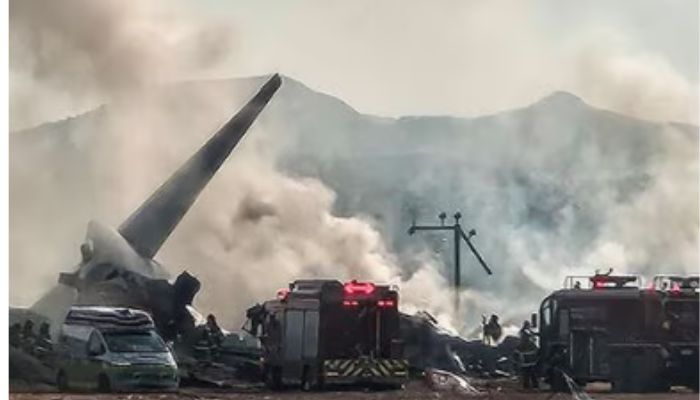Tragic Landing at Muan: South Korea's Deadliest Aviation Disaster in Recent History
On Sunday, December 29, 2024, South Korea witnessed one of its most devastating aviation tragedies. A Jeju Air Boeing 737-800 crashed at Muan International Airport, claiming 179 lives. The catastrophe, caused by a reported malfunction of the aircraft’s landing gear, has left the nation and the global aviation community in mourning.
The Incident
At 9:03 AM local time, the Jeju Air flight, returning from Bangkok, approached Muan International Airport, 290 kilometers south of Seoul. During its landing attempt, the aircraft's landing gear appeared to remain retracted, causing it to skid across the runway before crashing into a concrete wall at the airport's perimeter.
The impact ignited a massive fire, engulfing the aircraft and making rescue operations extremely challenging. Eyewitness footage revealed the harrowing sequence of events, sparking widespread grief and concern.
Casualties and Rescue Efforts
-
Onboard Statistics:
- Total Passengers: 181
- Fatalities: 179 (including passengers of multiple nationalities, such as Thai citizens)
- Survivors: 2 (both crew members, sustaining moderate to severe injuries)
-
Emergency Response:
- Over 1,570 emergency personnel, including firefighters, police, and military, were deployed.
- 32 fire trucks and helicopters worked tirelessly to contain the blaze and aid survivors.
- Both black boxes (flight data recorder and cockpit voice recorder) were recovered swiftly, promising crucial insights for the investigation.
Official and Airline Response
-
South Korean Government:
- Acting President Choi Sang-mok declared a seven-day national mourning period.
- Muan International Airport suspended all operations to focus on recovery and investigation efforts.
-
Jeju Air:
- CEO Kim E-bae issued a public statement accepting full responsibility for the incident.
- He expressed condolences to the victims' families and vowed full cooperation with investigative authorities.
Historical Context
This disaster has left an indelible mark on South Korea’s aviation history:
- It is Jeju Air’s first fatal accident since its establishment in 2005.
- The incident surpasses the 1997 Korean Airlines crash in Guam as the deadliest aviation disaster involving South Korea.
Aviation Disasters in South Korea
South Korea's aviation industry has long been recognized for its commitment to safety and modernization. However, the recent tragedy at Muan International Airport underscores the persistent challenges in ensuring accident-free skies.
Jeju Air’s First Fatal Incident
Since its inception in 2005, Jeju Air has built a reputation as one of South Korea’s leading low-cost carriers, with a strong focus on domestic and international short-haul routes.
- Flawless Record Until Now: This is the first fatal accident in Jeju Air’s nearly two-decade operational history, making the Muan crash a significant and heartbreaking deviation from its safety record.
- Growth and Expansion: Jeju Air's growth as a key player in Asian aviation adds gravity to this incident, as its reputation for safety is now under scrutiny.
Comparison to the 1997 Korean Airlines Crash
The Muan disaster has tragically eclipsed the 1997 Korean Airlines Flight 801 crash, which had previously been the most severe aviation accident involving South Korea.
- Flight 801 Incident:
- Date: August 6, 1997
- Location: Guam (U.S. territory)
- Casualties: 228 of the 254 passengers and crew on board lost their lives.
- Cause: Controlled flight into terrain due to pilot error and poor navigation in inclement weather.
- Implications for South Korea: The Guam crash led to significant reforms in pilot training, operational oversight, and safety protocols for South Korean carriers, establishing a safer era of aviation in the region.
Other Notable Incidents
-
Asiana Airlines Flight 214 (2013):
- Incident: Crash-landed at San Francisco International Airport.
- Casualties: 3 fatalities, 187 injuries.
- Cause: Pilot mismanagement during final approach.
- Impact: Raised concerns about pilot reliance on automated systems.
-
Korean Air Flight 015 (1980):
- Incident: Crashed during a landing attempt at Seoul’s Gimpo Airport.
- Casualties: 15 fatalities of 226 onboard.
Significance of the Muan Crash
The Muan tragedy highlights several themes in South Korea’s aviation history:
- Safety Milestones: Despite past reforms and an improving safety record, this incident underscores the continuous need for vigilance.
- Global Attention: As one of Asia’s key aviation hubs, South Korea faces heightened expectations to prevent such tragedies in the future.
- Modern Challenges: The reliance on aging fleets (e.g., the Boeing 737-800 in this crash) brings renewed focus to aircraft maintenance and technological upgrades.
International Response
The global community has extended its condolences and support:
- Pope Francis: Prayers for the victims and their families.
- German Chancellor Olaf Scholz: Sent official condolences.
- Boeing: Offered sympathies and initiated contact with Jeju Air.
- Thai Government: Mobilized assistance for affected Thai nationals.
Investigation and Looking Forward
Authorities are prioritizing a thorough investigation to determine the cause of the crash.
-
Factors Under Review:
- Suspected landing gear malfunction.
- Reports of a possible bird strike.
- Weather conditions and visibility at the time of the incident.
- Aircraft maintenance history.
-
Next Steps:
- Analysis of recovered black boxes.
- Examination of crew communication with the control tower.
- Comprehensive review of the aircraft’s maintenance records.
This tragedy highlights the critical importance of aviation safety and the relentless need for innovation and vigilance in the industry.
Conclusion
As South Korea observes a period of national mourning, the world joins in solidarity, honoring the lives lost and looking toward solutions that can prevent such calamities in the future. The Muan crash serves as a stark reminder of the challenges and responsibilities inherent in aviation, urging global stakeholders to enhance safety protocols and ensure the skies remain a secure space for all.

